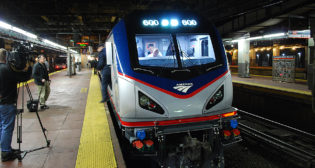
Roll Safe, Roll Silent
Written by Andrew Corselli
L.B. Foster photo.
RAILWAY AGE, JULY 2020 ISSUE: Friction management improves safety, serves as a cost reduction driver, reduces noise pollution and extends rail life. Curving physics involving the wheel/rail interface are basic: When a train passes through a curve, it generates forces that want to push the rails out of gauge. The magnitude of the force is directly related to axle loads.
This is more of an issue with heavily loaded railcars, says John Cotter, General Manager for Friction Management, North America, L.B. Foster. “That vertical force is translated into the lateral forces and pushes out the rail. It’s very comparative to the friction level. So if you can change the friction level, you can change the forces acting on the rail to prevent rail spreading.”

“I look at friction management as a three- or four-legged stool,” says Bruce Wise, Director of Business Development, Loram Maintenance of Way, Inc. – Friction Management. “You have the equipment, you have the consumables and you have the maintenance or service component. And in Loram’s case, we actually have the fourth leg of the stool with rail grinding. Friction management and rail grinding tend to go hand-in-hand. Optimizing both allows you to extend rail life and so forth, and gain fuel savings. So a three-legged stool is stable, but a four-legged stool is that much more stable. But if you lose one of the legs of that stool, the stool falls over.”
L.B. Foster
Friction management in the past 20 years has evolved into an acceptable global best practice, says Cotter. Indeed, many companies—freight and transit—do have some form of friction management program,
he says.
A typical call for friction management is high rail wear, such as when a railroad notices it is replacing a specific curve more frequently. The railroad is either going to implement a friction management program or question if its existing system or program is not working adequately.
“When managing friction at the wheel/rail interface, we want to drop the friction down to as low a level as possible between the wheel flange and the gauge face, in order to prevent wear,” Cotter says. “In that particular case, we’re trying to reduce it through traditional greases and lubricants down to as low as possible and maintain it in order to provide as low a friction level as possible.
“On the rail head, we can’t do the same because that surface is also where we require adhesion and braking to occur. So if we drop the friction level too low, on locomotives we’ll tend to see things like wheel slip. On transit systems, where braking is very important, we tend to see wheel lock-up and slides, which tend to lead to burns and skid marks on the rail.
“So on the rail heads, we want to introduce material backdrops of friction levels from a dry level (about 0.6 friction level) down to about nominally 0.3 or 0.4. So we’re trying to introduce materials into that interface, but bringing it down to what we call the intermediate range, to get the benefit of reduced friction.”
Traction enhancers, as the name implies, are the exact opposite. They’re designed to bring friction up from a low level to an intermediate level, according to Cotter. He says traction enhancers are typically used in specific situations, such as in the fall when leaves collect on the rails.
“When leaves decompose, they create very powerful lubricants, organic materials, that when intermingled with materials on top of the rail, they create a very low friction level,” he notes. “So you’re trying to overcome that existing material on the rail head to bring that pressure level up in order to ensure that you have adequate braking and adhesion.”
Loram
Wise concurs with Cotter about the practice’s evolution. And he adds that gauge face lubrication “has been around virtually since railroads first began operating.” Initially, it was done manually—literally with a pail and a brush. Workers would go out and apply grease, mainly to curves.
“So then, as the art evolved, automated systems for applying curve lubricant began,” he says. “There were mechanical lubricators that, as the train ran over them, activated either a ramp lever or a hydraulic-type plunger to pump grease out onto the track.
“Up until the mid-’90s, the only friction management applied was gauge-face grease or curve lubricant. Only in the past 20 years has top-of-rail (TOR) friction modification became another strategy. As we started to learn the wheel/rail interaction better, we started to see that there was some benefit from controlling the friction on the top of the rail as well. That’s when TOR friction modifiers first became available. Typically, those have always been applied with electronic lubricators, where there’s no contact between the wheel and the activation device.”
TOR friction modifiers typically are applied in smaller doses and much more precisely than curve lubricants, Wise says. That’s why an electronic lubricator that allows fine-tuning the output rate is needed.
“Back in the early days with the mechanical-type systems, every wheel pass pumped grease,” Wise notes. “So trying to adjust them was much more difficult because you were literally going to get some output with every wheel pass. We can set the electronic units that are around today and have them apply only as needed. Wheel skips built into the control systems allow you to only pump, for example, every six wheels, every eight wheels, etc., depending on how much you need to coat the specific area. The application art has come a long way.”
RBL
Bob Pieper, President, RBL, Inc./Robolube, has “sold Robolube Hyrail Lubricators to every Class I railroad.” He notes that Class I’s are the biggest users of Hyrail Lubricators, and “some of the lubricators have been designed specifically to accommodate the end user’s requirements for a specific vehicle.” RBL’s current customers include BNSF, CN, CP, CSX, G&W and others.
However, Pieper says that high-density lines cannot effectively be lubricated with a Hyrail unit. So he and RBL are taking the evolution a step further. RBL is in the process of finishing its new Robolube R2K Gauge Face Wayside Lubricator, with the first units in production now, in an effort to “give the industry a new technology that will provide them a better alternative and quickly realized cost savings at several levels. We’ve received excellent feedback on the idea: no-train-contact, using 75% less grease, virtually zero waste, cold weather operation and no requirement for hazardous mats to catch wasted grease. Now it’s just a matter of getting it out there to prove its benefits and letting it do its job.”

MPL
MPL Technology says it was “the first to bring solid polymer lubricants to the rail industry for flange lubrication and has continued to innovate with the development of its NatureBlend formulation. The benefits associated with flange lubrication include the following: saves fuel by reducing wheel/rail friction; significantly reduces flange wear; reduces frequency of wheel truing; increases wheel life; increases rail life; and reduces reliance on trackside lubricators.”
The NatureBlend formulation was developed in an effort “to provide a more environmentally friendly form of polymer lubricants. The formulation uses renewable and biodegradable polymers and oils to provide the rail industry with an alternative to traditional hydrocarbon-based lubricants.” MPL says it’s available in a wide variety of shapes and sizes to fit most flange lubrication applicators.
“The formulation was developed in conjunction with Kansas State University and has been tested at a wide range of test facilities including the National Research Council of Canada and the Transportation Technology Center,” MPL notes. “Test results prove the formulation’s ability to effectively transfer onto steel surfaces and provide friction reduction for a prolonged period of time. Testing at TTCI documented the formulation’s ability to reduce energy required through friction reduction. This was measured through both electrical and mechanical force reduction.”
Methods
When it comes to each railroad’s methods for conducting friction management/lubrication testing, no two are alike. Many variables are in play. Testing frequency depends on traffic density, MGT, degree of curvature and superelevation. The customer has to consistently monitor the location.
The growth area is remote equipment monitoring. Not long ago, the only way to know if a lubricator was working was to physically inspect it. Now there are systems that remotely monitor the equipment, where an inspector could sit at computer and look and see which lubricators are working. Many wayside systems are solar-powered, equipped with sensors that monitor the voltage.



